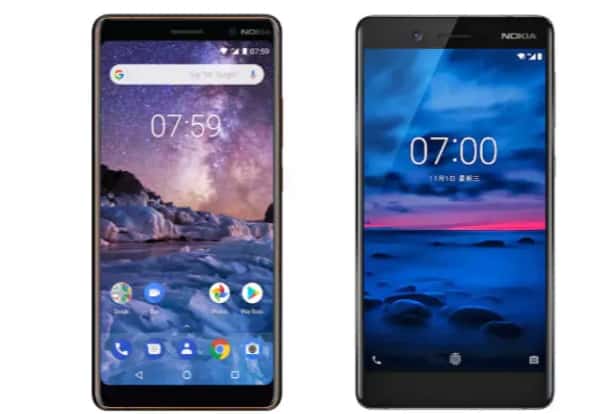
HMD Global on Sunday unveiled the Nokia 7 Plus ahead of Mobile World Congress (MWC) 2018 in Barcelona to upgrade the experience over the original Nokia 7. The new smartphone has enhanced specifications as well as an all-new build. Also, the latest Nokia phone is a part of Google’s Android One initiative that is aimed to offer a vanilla experience with no customisations on top of stock Android. The handset additionally comes with new colour options to distinguish the looks from its predecessor. Therefore, here’s a quick rundown of differences between the Nokia 7 and Nokia 7 Plus to highlight what’s new and better by the Finnish giant.
Nokia 7 Plus vs Nokia 7 price
Nokia 7 Plus price is set at EUR 399 (approximately Rs. 31,750), excluding taxes and subsidies. The Nokia 7, on the other hand, was launched in China in October last year in two variants: the 4GB RAM version was priced at CNY 2,499 (around Rs. 25,600), whereas its 6GB RAM variant was debuted at CNY 2,699 (roughly Rs. 27,650). Price of the Nokia 7 Plus in India is yet to be reveal, though it will go on sale starting April in Black/ Copper and White/ Copper colour options.
Nokia 7 Plus vs Nokia 7 specifications
The Android 8.0 Oreo-based Nokia 7 Plus is backed by Android One programme and thus doesn’t include any proprietary customisation effects. The smartphone features a 6-inch full-HD+ (1080×2160 pixels) IPS display with an 18:9 aspect ratio, 500-nits brightness rating, and Corning Gorilla Glass. Under the hood, there is an octa-core Qualcomm Snapdragon 660 SoC, coupled with 4GB of LPDDR4 RAM. The smartphone has a dual rear camera setup that comprises a 12-megapixel wide-angle primary image sensor with an f/1.75 aperture and is 1.4-micron pixels size and a 13-megapixel secondary sensor with an f/2.6 aperture lens that supports 2x optical zoom. The dual camera setup is accompanied by a dual-tone LED flash and Zeiss optics. On the front, the smartphone sports a 16-megapixel fixed focus camera with an f/2.0 aperture and Zeiss optics on top.
On the part of its storage, the Nokia 7 Plus has 64GB of onboard storage that is expandable via microSD card (up to 256GB). The smartphone has 4G VoLTE, Wi-Fi 802.11ac, Bluetooth v5.0, GPS/ A-GPS, NFC, USB Type C (2.0), and a 3.5mm audio jack. Sensors on board include an accelerometer, ambient light sensor, digital compass, gyroscope, proximity sensor, and a rear-facing fingerprint sensor. The smartphone has a single speaker that is powered by a smart amplifier and Nokia spatial audio that is powered by three built-in microphones. Besides, it packs a 3800mAh battery, supporting fast charging, and measures 158.38×75.64×7.99mm (going up to 9.55mm around the camera bump).
In contrast, the Nokia 7 came with Android 7.1.1 Nougat, though it received an update to Android 8.0 Oreo last month. The smartphone has a 5.2-inch full-HD (1080×1920 pixels) IPS display with a Corning Gorilla Glass 3 protection on top. It is powered by a 1.8GHz octa-core Qualcomm Snapdragon 630 SoC, which is paired with 4GB and 6GB RAM options. The handset has a single 16-megapixel rear camera sensor with an f/1.8 aperture – unlike the dual rear camera setup-featuring Nokia 7 Plus. The rear camera sensor on the original Nokia 7 does include a dual tone LED flash. The handset also has a 5-megapixel front camera sensor with an f/2.0 aperture.
The Nokia 7 has 64GB onboard storage that is expandable via microSD card (up to 128GB). In terms of connectivity, there is 4G LTE, Wi-Fi, Bluetooth v5.0, GPS/ A-GPS, NFC, and USB Type-C port. The handset has a fingerprint sensor on the back. Lastly, it packs a 3000mAh battery and measures 141.2×71.4×7.9mm.
